Impact of Dead Sea Halo-Karst Development on an Earthen Dike Rehabilitation Project
Abstract
1. Introduction
1.1. Problem Statement
1.2. Environmental Setting
1.3. Geo-Structural Setting
- The Sedom Formation. It consists of rock salt with lamina of silt and gypsum [13]. In the Dead Sea Basin, it may be shallow in depth within the Lisan peninsula and crops out in Mount Sedom on the western side of the Dead Sea, in a smaller salt dome. The Sedom lagoon developed into the Lisan Lake after being cut off from the Mediterranean Sea.
- The late Pleistocene Lisan Marl (~120 m). They are thinly laminated marl with gypsum, cross-bedded calcarenite sand, and oolites deposited in the saline lake [14]. Facies change to gravel in the regression deposits at the lake edges.
- The Holocene surficial deposits. They are made of evaporates, crystalline halite, laminated marl, inter-fingered with clay, silt, sand, and gravel that had been deposited in deep to shallow water.
1.4. Dead Sea Halo Karst System Resulting from the Lake Level Drop
2. Materials and Methods
2.1. Advanced Differential Radar Interferometry Technique
2.2. Data
3. Results
3.1. Geomorphological Map of SP-0B
- The plastic nature of the emerged soft clay layers.
- The amount of gravitational potential energy of the recently emerged sediments depends on the height and mass above the base level (Dead Sea). Thus, the lower the base level, the greater the movement of deformable sediments such as soft clays.
- The groundwater injection owing to geological discontinuities is activated both by the rise of the Lisan diapir, the strike-slip tectonics, and by the isostatic readjustment linked to the lowering of the Dead Sea level. Blocked downwards by the hard salt layer, the soft clay can essentially creep laterally. However, locally, downward movements by infiltrating the weakness zones could occur and could explain the lateral variation of the soft clay thickness across the entire salt pan SP-0B, from 5 m up to 60 m.
3.2. Rehabilitation Works of SP-0B
3.3. Ground Deformation Fields
3.3.1. Subsidence
3.3.2. Uplift
3.3.3. Deformation Maps
4. Discussion
- A large (but precisely unknown) volume of water that is undersaturated with salt is drained towards the Lisan peninsula. The adduction network is also unknown. The water probably arrives from the adjacent Mazra’a–Ghor Al Haditha region through a network of major faults oriented globally N-S and related to the strike-slip tectonics of the Dead Sea basin. From investigations in Ghor Al Haditha [16,17], another possibility would be a water transfer from a 3D karst system developed along groundwater flows. The latest being not necessarily related to the tectonic setting.
- The presence of relatively fresh water is attested by the permanence of Tamarix vegetation on the Lisan plateau. With the abandonment of SP-0B after March 2000, Tamarix bushes developed in a specific place next to CH 7 + 200. They were photographed for the very first time in 2005 (Figure 7B). From that observation, we can deduce that the water stored in the peninsula is moving along a North-South axis below the wave-cut platform to pour out into the Dead Sea.
- During a field visit in April–May 2005, a perennial stream was observed in the destroyed area of dike 19. From 2007 onwards, it dried up.
- Along the eastern side of the peninsula, sinkholes and underwater springs were observed in the shallow waters from open source (Google Earth historical imagery) very high-resolution satellite imagery.
- In the extraction zone (used to build new dike 19) located in the north of the peninsula, the deepest depressions reached the water table and semi-permanent ponds appeared on satellite images (Bing map and Google Earth historical imagery).
- The unsaturated water is at the origin of the development of cave networks. The size of this network is unknown but five major entrances were inspected during fieldworks. All studied caves developed along N-S oriented fractures.
- Among the sub horizontal Lisan deposit layers covering the salt diapir, the APC engineers recognized two overlaid layers with particular properties: on top, a layer of soft clay; below, a layer of consolidated salt. The mechanical properties of the soft clay (marls) layer are responsible for many stability problems for SP-0A and SP-0B. The hard salt layer has a thickness of about 10 m. It has been found in many places around the Dead Sea [19]. Therefore, this salt layer is believed to be responsible for thousands of sinkholes. It can be fragmented by faults through which unsaturated water with respect to salt circulates under pressure. This characteristic also appeared in the tender documents.
- Ground deformation data come from radar satellite images. Three independent data sets were used: ERS, Envisat, and Sentinel-1. Data refer to the 1990s; 2000s; and 2010s.
- The strain fields are relatively similar in terms of spatial extent. Two very contrasting zones appear juxtaposed: a vast zone in uplift concerns the old part of the peninsula and a significant part of the wave-cut platform. The second zone is, on the contrary, a zone in strong subsidence. The highest values co-occur with a 60 m thick, soft to very soft, highly compressible, and relatively impervious laminated silty clays.
- There is an intermediate transition zone. The size of this zone is, however, reduced compared to the other two zones. In other words, we observe a high gradient of ground displacements.
- The fractures and landslides that developed after March 2000 on the remaining dike segments of SP-0B result from the tensions between the two aforementioned zones.
- The permanence of the subsidence/uplift pattern over three decades suggests that the Lisan diapir is an active structure. The increase in the velocity values is obvious. However, it is not clear whether the movements are caused by the rise of the diapir only. Given the observations performed along the coasts of the Dead Sea, it is likely that what is observed north of the Lisan Peninsula is a combination of movements related to the uplift of the salt diapir and of the lowering of the Dead Sea level. The proximity of the two phenomena applied to the 60 m thick very soft silty clays would explain why this part of the Dead Sea coast displays the highest subsidence rates.
- For more than 20 years, the safety engineers have experienced dike stability challenges over the Lisan peninsula. Arab Potash invested a lot to preserve SP-0A from the fate of SP-0B. The “strategy” of widening the dike to increase the safety coefficient is debatable. Indeed, the experience with SP-0A has shown the limits of this approach. Since early 2015, SP-0A salt pan has been amputated from its southern part due to the development of a major karstic network during the last 30 years [28].
- The greatest subsidence values are located along the shore of the Dead Sea. However, as the coastline moves further and further away from the new dike 19, it is likely that the tensions created by the subsidence will be more and more reduced.
- The link between the uplift of the salt diapir and the adjacent subsidence is not obvious. Mechanically, the uplift in one place implies a lowering by compensation at the periphery of the uplifted zone. In short, the subsidence rates observed along the northern coast of the Lisan results both from the compaction of the sediment and from the movement compensating for the uplift of the salt diapir.
- On the other hand, it is not easy to demonstrate that the lowering of the level of the Dead Sea would have an impact on the dynamics of the diapir uplift. Again, mechanically speaking, we can understand that the fact of removing a water layer of ~40 m during the last fifty years leads to a decompression movement that could favor locally uplift movements.
- The instrumentation of the new dike 19 with a considerable number of sensors should allow the engineers to detect in time the subsidence linked to the unavoidable development of karstic networks. The sustainability of APC investments also depends on the responsiveness of the surveillance teams and the means at their disposal to backfill the collapsed areas.
5. Conclusions
Author Contributions
Funding
Data Availability Statement
Acknowledgments
Conflicts of Interest
References
- Closson, D.; Abou Karaki, N.; Hansen, H.; Derauw, D.; Barbier, C.; Ozer, A. Space-borne radar interferometric mapping of precursory deformations of a dyke collapse, Dead Sea area, Jordan. Int. J. Remote Sens. 2003, 24, 843–849. [Google Scholar] [CrossRef]
- Rogers, J.D. Innovative Solutions for Water Wars in Israel, Jordan and the Palestinian Authority. In Proceedings of the International Conference on Military Geology and Geography, United States Military Academy at West Point, New York, NY, USA, 15–18 June 2003; Available online: https://web.mst.edu/rogersda/umrcourses/ge342/Article-Innovative%20Solutions%20Water%20Wars%20with%20header.pdf (accessed on 25 January 2023).
- Closson, D.; Karaki, N.A. Dikes Stability Monitoring Versus Sinkholes and Subsidence, Dead Sea Region, Jordan. In Land Applications of Radar Remote Sensing; Holecz, F., Pasquali, P., Milisavljevic, N., Closson, D., Eds.; IntechOpen: London, UK, 2014; pp. 281–307. [Google Scholar]
- Masannat, Y.M. Stability of Natural Slopes and Embankments Underlain by Weak Clays. In Proceedings of the Sixth Jordanian International Civil Engineering Conference (JICEC06), Session 1B Geotechnical, Amman, Jordan, 10 March 2015. [Google Scholar]
- Arab Potash Company. Annual Report 2013. Available online: www.arabpotash.com/ebv4.0/root_storage/en/eb_list_page/annual_report_2013.pdf (accessed on 20 September 2022).
- Jordan to Prequalify Firms for Dykes Project. Available online: www.meed.com/jordan-to-prequalify-firms-for-dykes-project/ (accessed on 20 September 2022).
- Interim Condensed Consolidated Financial Statement. Available online: www.arabpotash.com/ebv4.0/root_storage/en/eb_list_page/first_quarter_2022.pdf (accessed on 20 September 2022).
- Fiaschi, S. Differential radar Interferometry Applied to the Detection and monitoring of Geological Hazards. Corso Di Dottorato Di Ricerca. In Scienze Della Terra; Universita Degli Studi: Di Padova, Italy, 2017. [Google Scholar]
- Fiaschi, S.; Closson, D.; Abou Karaki, N.; Pasquali, P.; Riccardi, P.; Floris, M. The complex karst dynamics of the Lisan Peninsula revealed by 25 years of DInSAR observations. Dead Sea, Jordan. ISPRS J. Photogramm. Remote Sens. 2017, 130, 358–369. [Google Scholar] [CrossRef]
- The Level of the Dead Sea from 1976. Available online: data.gov.il/dataset/https-www-data-gov-il-dataset-683/resource/823479b4-4771-43d8-9189-6a2a1dcaaf10 (accessed on 7 July 2022).
- Abu Ghazleh, S. Lake Lisan and the Dead Sea: Their Level Changes and the Geomorphology of their Terraces. In Dissertation zur Erlangungen des Gerades eines Doktors der Naturwissenschaften; Technische Universität Darmstadt: Darmstadt, Germany, 2011. [Google Scholar]
- Western Atlas. Seismic Interpretation and Seismic Modelling of the El-Lisan Peninsula, Dead Sea; Report Prepared for Natural Resources Authority of Jordan; Western Atlas: Houston, TX, USA, 1994; p. 133. [Google Scholar]
- Matmon, A.; Fink, D.; Davis, M.; Niedermann, S.; Rood, D.; Frumkin, A. Unraveling rift margin evolution and escarpment development ages along the Dead Sea fault using cosmogenic burial ages. Quat. Res. 2014, 82, 281–295. [Google Scholar] [CrossRef]
- Sunna, B.F. The geology of salt deposits in the Lisan peninsula—Dead Sea. In Proceedings of the Seminar on Salt in the Arab World, Ministry of Energy and Mineral Resources, Natural Resources Authorities, Amman, Jordan, 4–6 May 1986. [Google Scholar]
- Abou Karaki, N. Synthèse et carte sismotectonique des pays de la bordure orientale de la Méditerranée: Sismicité du système de failles du Jourdain-Mer Morte. PhD Thesis—Sciences Géophysique, Université Louis Pasteur de Strasbourg, Institut de Physique du Globe, Laboratoire de Sismologie, Strasbourg, France, 12 June 1987. [Google Scholar]
- Al-halbouni, D.; Watson, R.A.; Holohan, E.P.; Meyer, R.; Polom, U.; Dos Santos, F.M.; Comas, X.; Alrshdan, H.; Krawczyk, C.M.; Dahm, T. Dynamics of hydrological and geomorphological processes in evaporite karst at the eastern Dead Sea—A multidisciplinary study. Hydrol. Earth Syst. Sci. 2021, 25–26, 3351–3395. [Google Scholar] [CrossRef]
- Vey, S.; Al-Halbouni, D.; Haghighi, M.H.; Alshawaf, F.; Vüllers, J.; Güntner, A.; Dick, G.; Ramatschi, M.; Teatini, P.; Wickert, J.; et al. Delayed subsidence of the Dead Sea shore due to hydro-meteorological changes. Sci. Rep. 2021, 11, 13518. [Google Scholar] [CrossRef]
- Ezersky, M.; Eppelbaum, L.; Legchenko, A.; Al-Zoubi, A.; Abueladas, A. Salt layer characteristics in the Ghor Al-Haditha area, Jordan: Comprehensive combined reprocessing of geophysical data. Environ. Earth Sci. 2021, 80–84, 124. [Google Scholar] [CrossRef]
- Abelson, M.; Yechieli, Y.; Baer, G.; Lapid, G.; Behar, N.; Calvo, R.; Rosensaft, M. Natural versus human control on subsurface salt dissolution and development of thousands of sinkholes along the Dead Sea coast. J. Geophys. Res. Earth Surf. 2017, 122, 1262–1277. [Google Scholar] [CrossRef]
- Arkin, Y.; Gilat, A. Dead Sea sinkholes—An ever-developing hazard. Environ. Geol. 2000, 39, 711–722. [Google Scholar] [CrossRef]
- Yizhaq, H.; Ish-Shalom, C.; Raz, E.; Ashkenazy, Y. Scale-free distribution of Dead Sea sinkholes: Observations and modeling. Geophys. Res. Lett. 2017, 44, 4944–4952. [Google Scholar] [CrossRef]
- Lanari, R.; Casu, F.; Manzo, M.; Zeni, G.; Berardino, P.; Manunta, M.; Pepe, A. An Overview of the Small BAseline Subset Algorithm: A DInSAR Technique for Surface Deformation Analysis. Pure Appl. Geophys. 2007, 164, 637–661. [Google Scholar] [CrossRef]
- Galve, J.; Pérez-Peña, J.; Azañón, J.; Closson, D.; Caló, F.; Reyes-Carmona, C.; Jabaloy, A.; Notti, D. Evaluation of the SBAS InSAR service of the European space agency’s geohazard exploitation platform (GEP). Remote Sens. 2017, 9, 1291. [Google Scholar] [CrossRef]
- Woods Ballard, T.J.; Brice, G.J. Arab Potash Solar Evaporation system: Design. Proc. Inst. Civ. Eng. 1984, 76, 145–163. [Google Scholar] [CrossRef]
- El-Mossallamy, Y.; Ghalayini, I.; Demerdash, M.; Hammad, W. Design Considerations for Offshore Structures in the Dead Sea. In Proceedings of the 17th International Conference on Soil Mechanics and Geotechnical Engineering, Bibliotheca Alexandrina, Alexandria, Egypt, 5–9 October 2009. [Google Scholar]
- The Rehabilitation and Reinstatement Works of Dike 19. Available online: www.gecomjo.com (accessed on 25 January 2023).
- Closson, D.; Abou Karaki, N.; Pasquali, P.; Riccardi, P. A 300m-width sinkhole threatens the stability of the embankment of a saltpan in Jordan, Dead Sea Region. In Proceedings of the A 300m-Width Sinkhole Threatens the Stability of the Embankment of a Saltpan in Jordan, Dead Sea Region, EGU General Assembly 2013, Vienna, Austria, 7–12 April 2013. [Google Scholar]
- Closson, D.; Abou Karaki, N. Earthen Dike Leakage at the Dead Sea. In Engineering Geology for Society and Territory; Lollino, G., Manconi, A., Guzzetti, F., Culshaw, M., Bobrowsky, P., Luino, F., Eds.; Springer: Berlin, Germany, 2015; Volume 5, pp. 461–464. [Google Scholar]
- Al-Taraza, E. Detecting Earth Cracks Utilizing Seismic Refraction Technique in the Lisan Peninsula, Dead Sea, Jordan. Abhath Al-Yarmouk Basic Sci. Eng. 2004, 13, 147–160. [Google Scholar]




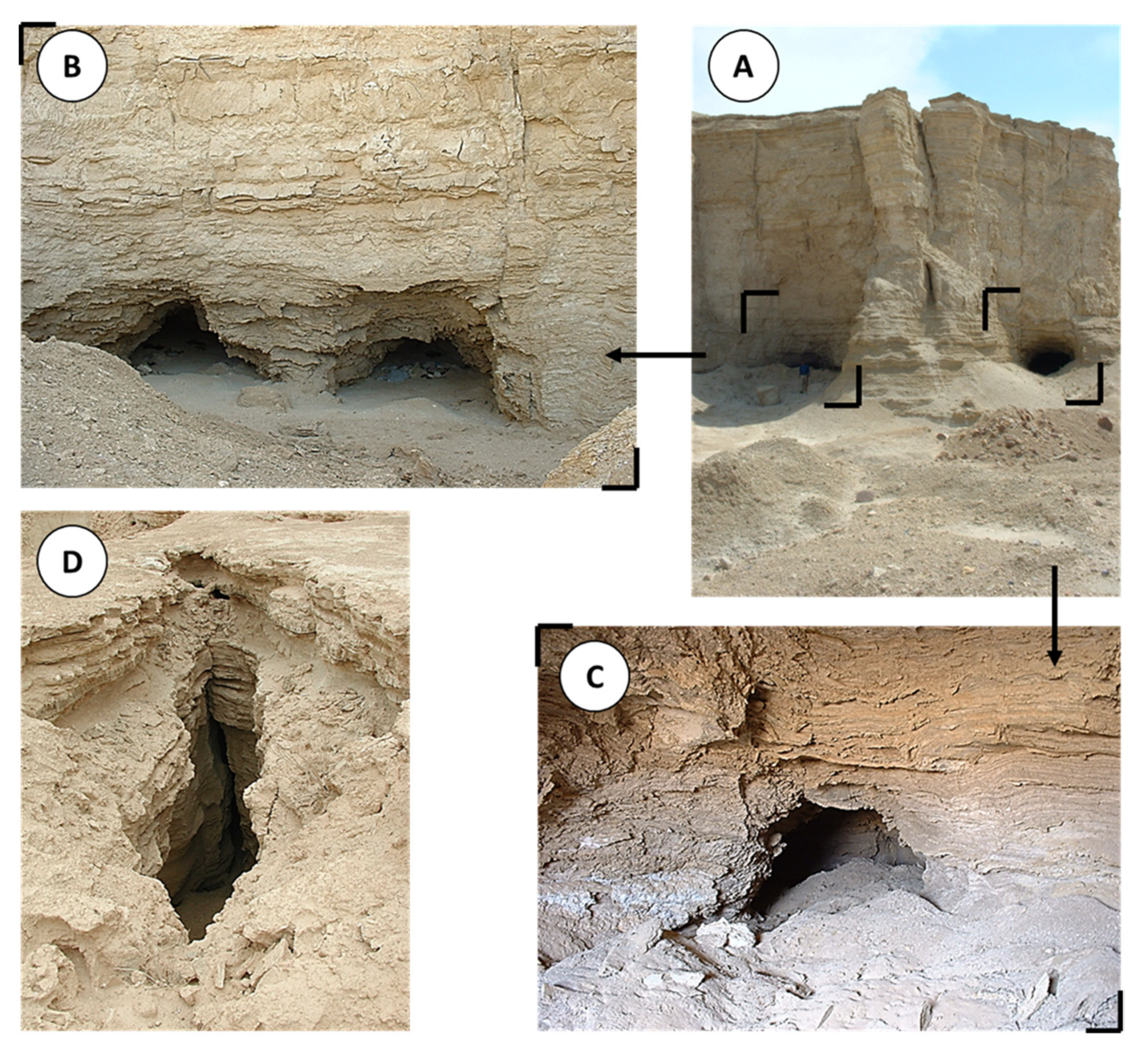
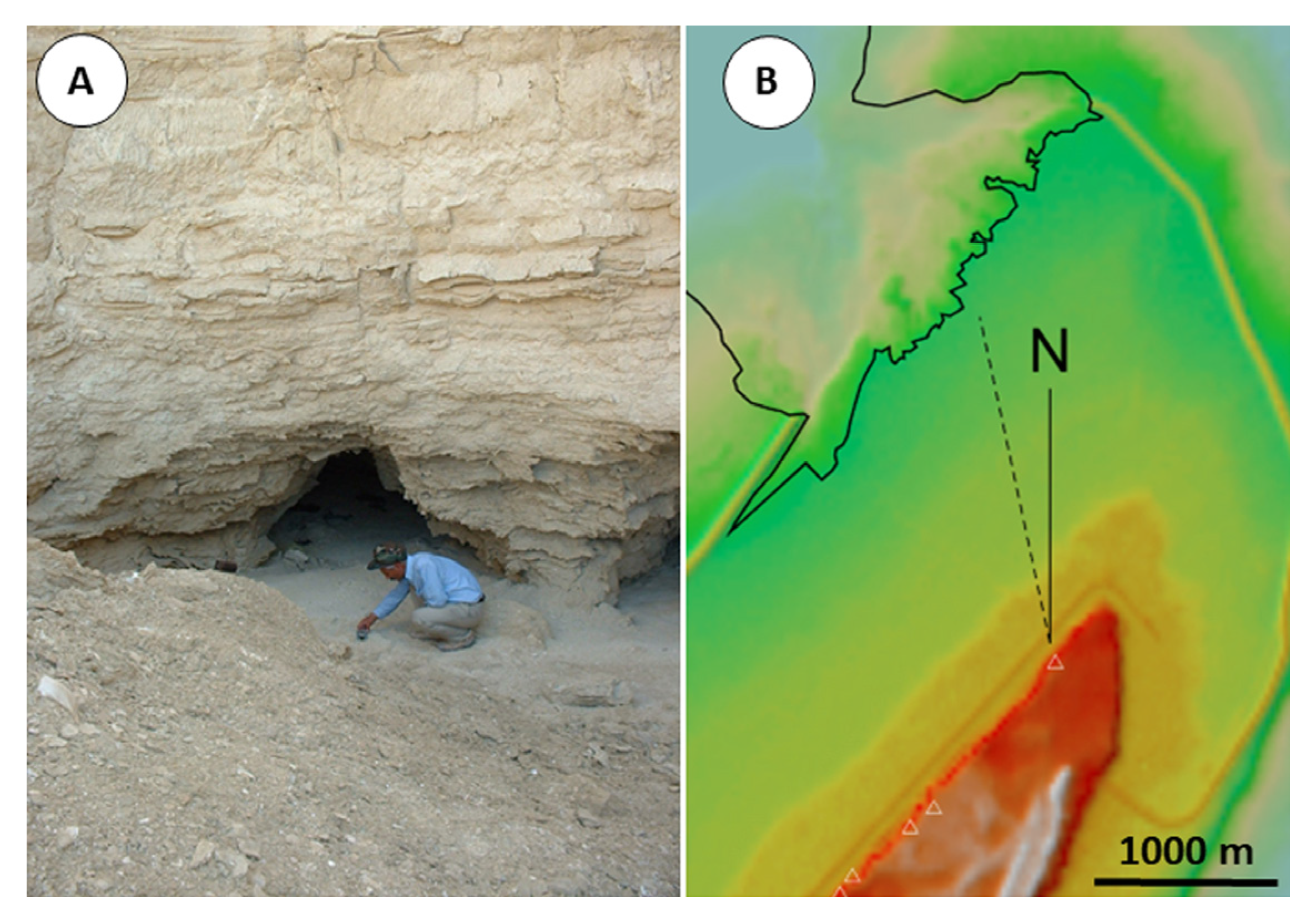
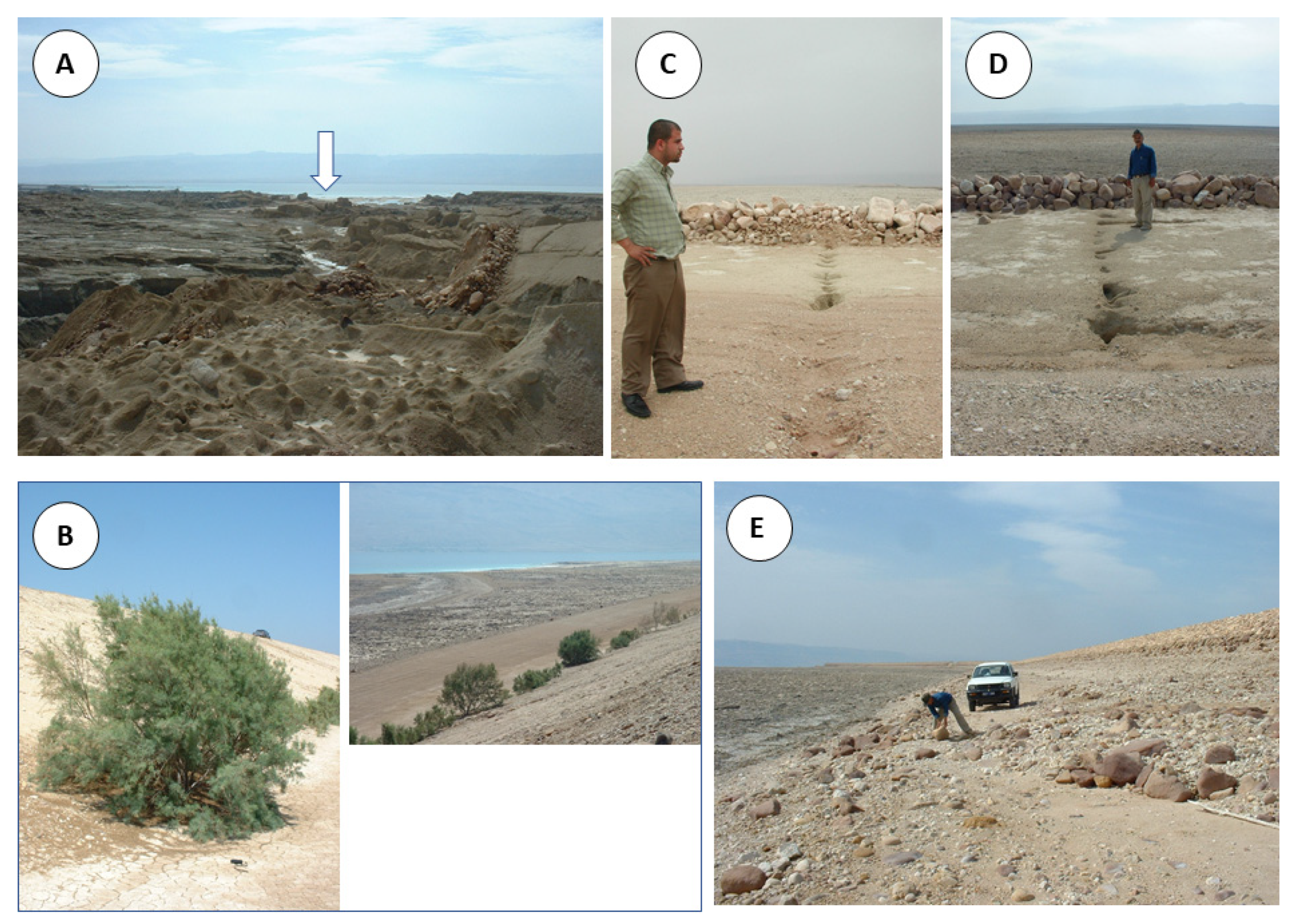
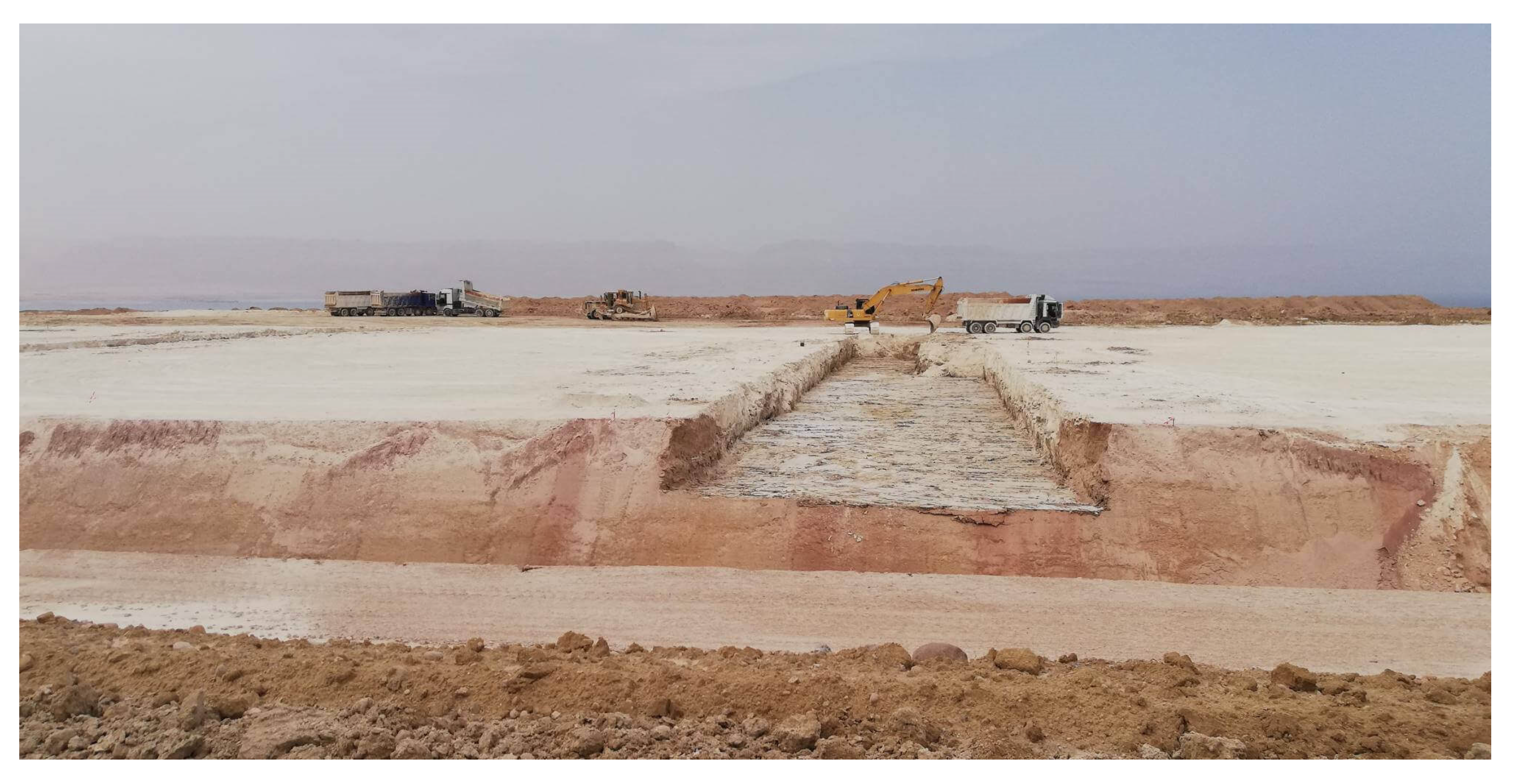
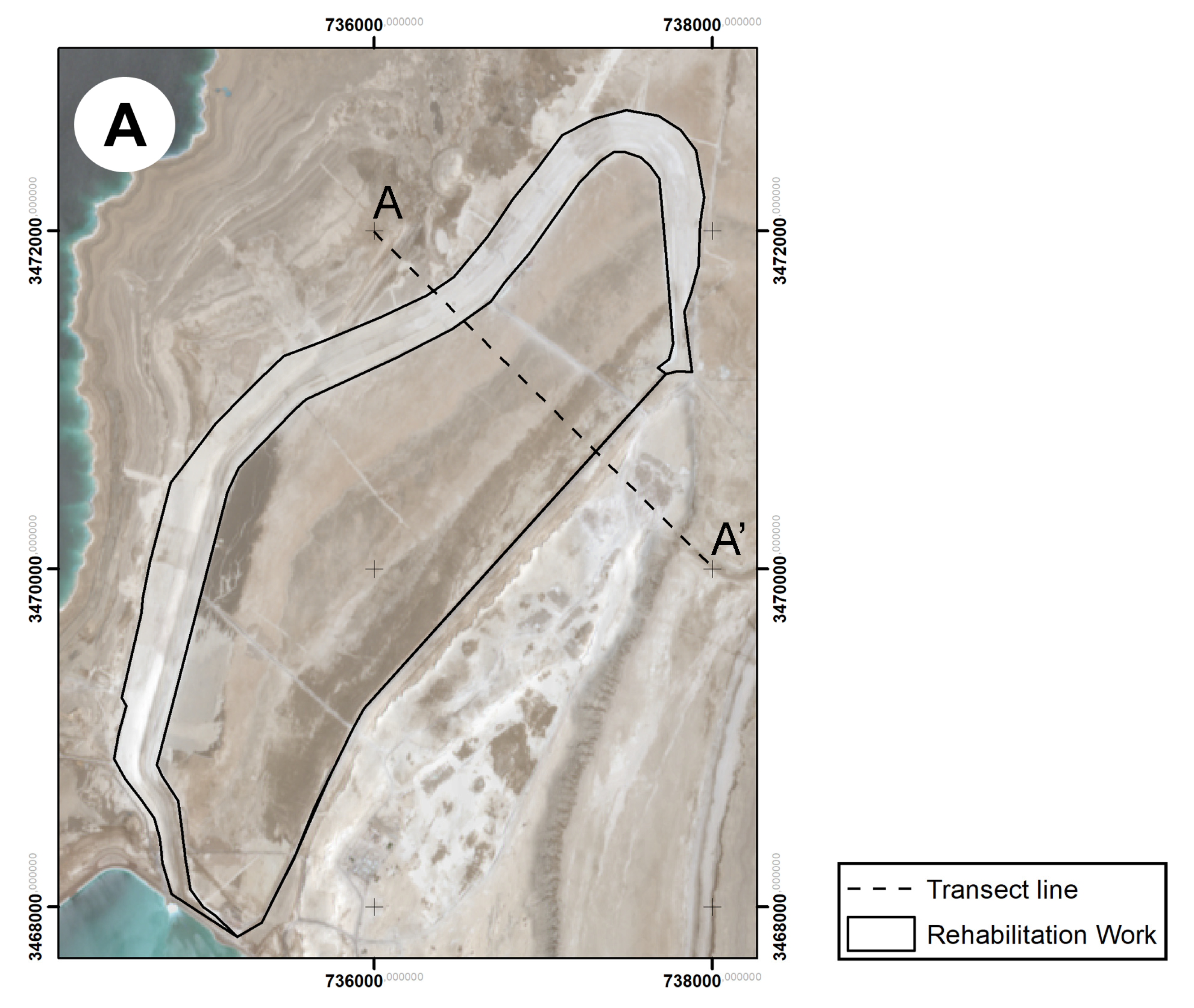
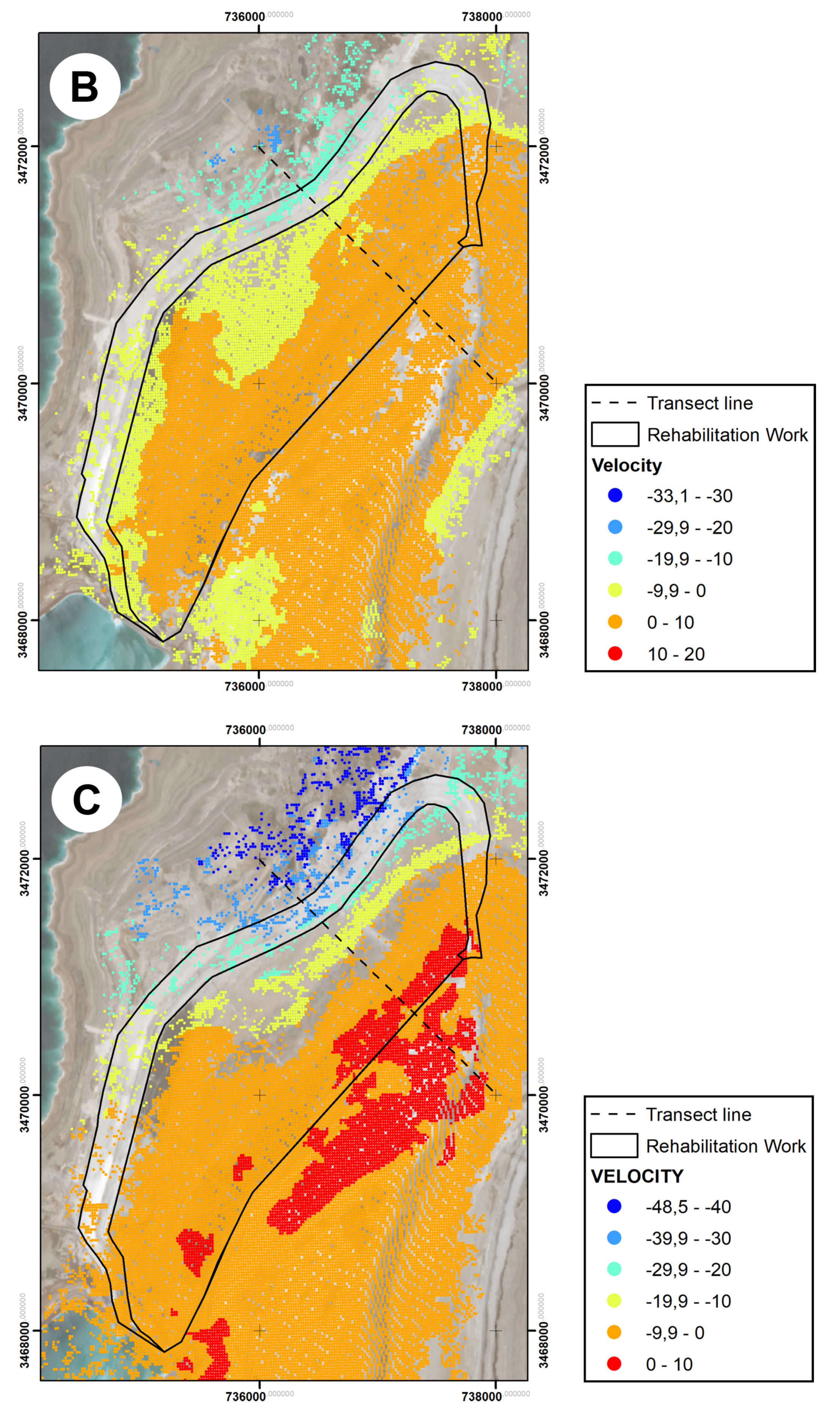

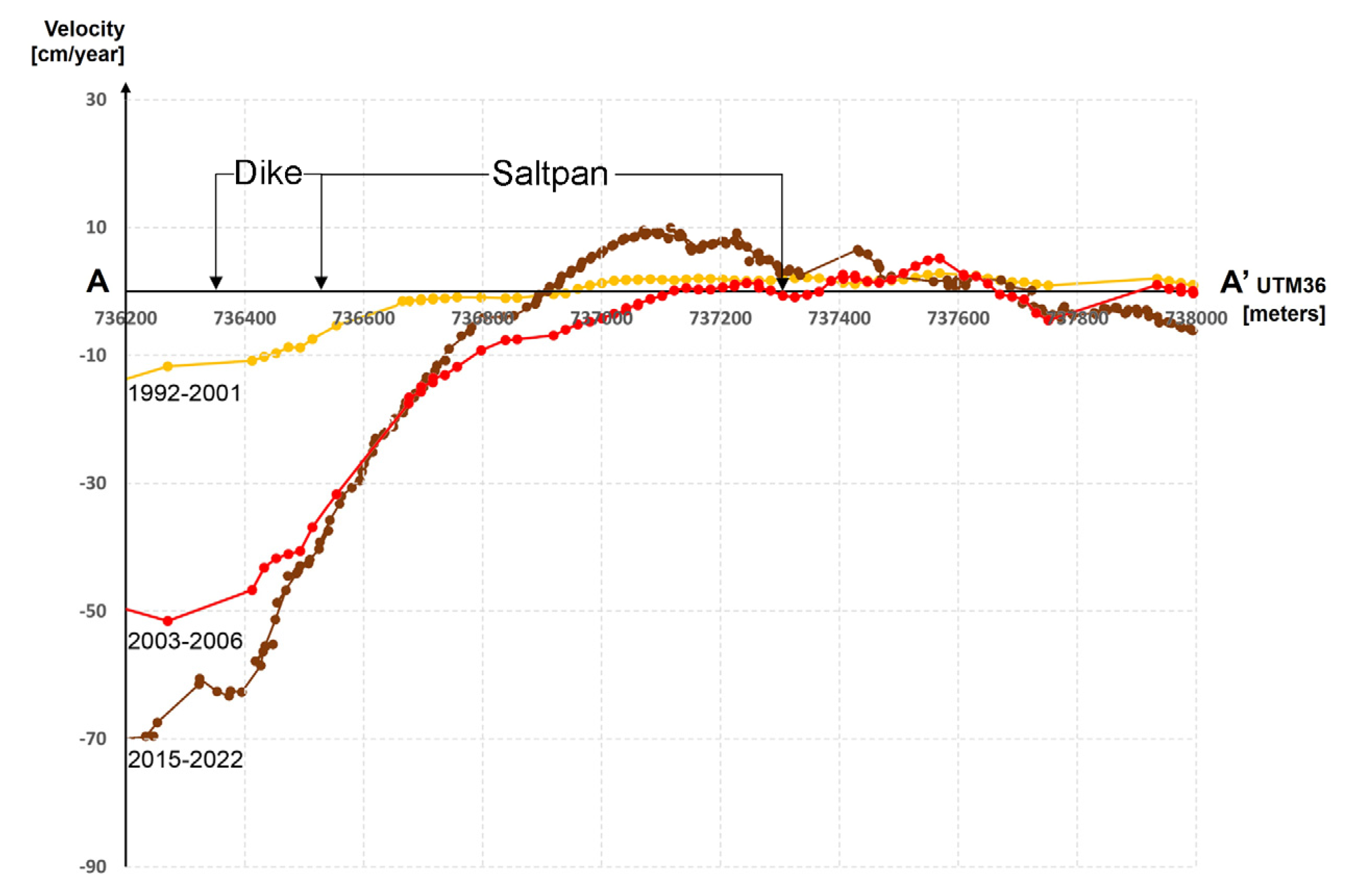
Disclaimer/Publisher’s Note: The statements, opinions and data contained in all publications are solely those of the individual author(s) and contributor(s) and not of MDPI and/or the editor(s). MDPI and/or the editor(s) disclaim responsibility for any injury to people or property resulting from any ideas, methods, instructions or products referred to in the content. |
© 2023 by the authors. Licensee MDPI, Basel, Switzerland. This article is an open access article distributed under the terms and conditions of the Creative Commons Attribution (CC BY) license (https://creativecommons.org/licenses/by/4.0/).
Share and Cite
Closson, D.; Patil, A.; Musthafa, M.; Gallagher, M.; Das, N. Impact of Dead Sea Halo-Karst Development on an Earthen Dike Rehabilitation Project. Geosciences 2023, 13, 42. https://doi.org/10.3390/geosciences13020042
Closson D, Patil A, Musthafa M, Gallagher M, Das N. Impact of Dead Sea Halo-Karst Development on an Earthen Dike Rehabilitation Project. Geosciences. 2023; 13(2):42. https://doi.org/10.3390/geosciences13020042
Chicago/Turabian StyleClosson, Damien, Akshay Patil, Mohamed Musthafa, Megan Gallagher, and Nitin Das. 2023. "Impact of Dead Sea Halo-Karst Development on an Earthen Dike Rehabilitation Project" Geosciences 13, no. 2: 42. https://doi.org/10.3390/geosciences13020042
APA StyleClosson, D., Patil, A., Musthafa, M., Gallagher, M., & Das, N. (2023). Impact of Dead Sea Halo-Karst Development on an Earthen Dike Rehabilitation Project. Geosciences, 13(2), 42. https://doi.org/10.3390/geosciences13020042











